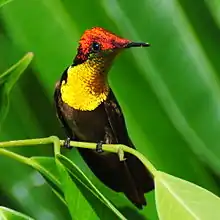Ruby-topaz hummingbird
The ruby-topaz hummingbird (Chrysolampis mosquitus), commonly referred to simply as the ruby topaz, is a small bird that breeds in tropical northern South America from Colombia, Venezuela and the Guyanas, south to central Brazil and northern Bolivia; also from Colombia into southern Panama and Trinidad. It is the only species placed in the genus Chrysolampis. It is a seasonal migrant, although its movements are not well understood.
| Ruby-topaz hummingbird | |
|---|---|
 | |
| In Bonaire | |
| Scientific classification | |
| Kingdom: | Animalia |
| Phylum: | Chordata |
| Class: | Aves |
| Order: | Apodiformes |
| Family: | Trochilidae |
| Genus: | Chrysolampis Boie, F, 1831 |
| Species: | C. mosquitus |
| Binomial name | |
| Chrysolampis mosquitus | |
| Synonyms | |
|
Trochilus mosquitus (protonym) | |
Taxonomy
The ruby-topaz hummingbird was formally described by the Swedish naturalist Carl Linnaeus in 1758 in the tenth edition of his Systema Naturae under the binomial name Trochilus mosquitus.[2] Linnaeus mistakenly believed that this hummingbird occurred in India (Habitat in Indiis) but the species only occurs in South America and the type locality has been redesignated as Suriname.[3] The ruby-topaz hummingbird is now the only species placed in the genus Chrysolampis that was introduced by the German zoologist Friedrich Boie in 1831.[4][5] The name Chrysolampis is from the Ancient Greek khrusolampis meaning "glow-worm". The specific name mosquitus is a Spanish diminutive and means "little fly".[6] The species is monotypic: no subspecies are recognised.[5]
Description
This hummingbird inhabits open country, gardens and cultivation. It is 8.1 cm long and weighs 3.5 g. Compared to most other hummingbirds, the almost straight, black bill is relatively short.
The male has green-glossed dark brown upperparts. The crown and nape are glossy red, and the throat and breast are brilliant golden-orange. The rest of the underparts are brown, and the chestnut tail is tipped black. The male often looks very dark, until he turns and the brilliant colours flash in the sunlight.
The female ruby-topaz hummingbird has bronze-green upperparts and pale grey underparts. The tail is chestnut with a dark subterminal band and a white tip. Females from Trinidad typically have a greenish throat-streak (it may appear dark), but this is not common elsewhere in its range. Juvenile females are similar to adult females, but with a white-tipped dusky-brown tail. Juvenile males resemble the juvenile female, but with a variable amount of iridescent orange to the throat.
The call of this species is a high-pitched tsip.
Behaviour
The female ruby-topaz hummingbird lays two eggs in a tiny cup nest in the fork of a low branch. Incubation takes 16 days, and fledging another 18 or 19.
The food of this species is nectar, taken from a wide variety of flowers, and some small insects. Ruby-topaz hummingbird males perch conspicuously and defend their territories aggressively.
Gallery
_male_in_flight.jpg.webp) Male in flight
Male in flight_RPPN_Frei_Caneca%252C_Jaqueira%252C_PE.jpg.webp) Male in flight
Male in flight.jpg.webp) Female in flight
Female in flight_female.jpg.webp) Female (left)
Female (left) Male
Male Male by Georges-Louis Leclerc de Buffon (1707-1788)
Male by Georges-Louis Leclerc de Buffon (1707-1788)
References
- BirdLife International (2012). "Chrysolampis mosquitus". IUCN Red List of Threatened Species. 2012. Retrieved 26 November 2013.CS1 maint: ref=harv (link)
- Linnaeus, Carl (1758). Systema Naturae per regna tria naturae, secundum classes, ordines, genera, species, cum characteribus, differentiis, synonymis, locis (in Latin). Volume 1 (10th ed.). Holmiae (Stockholm): Laurentii Salvii. p. 120.
- Peters, James Lee, ed. (1945). Check-List of Birds of the World. Volume 5. Cambridge, Massachusetts: Harvard University Press. p. 28.
- Boie, Friedrich (1831). "Bemerkungen über Species und einige ornithologische Familien und Sippen". Isis von Oken (in German). Cols 538–548 [546].
- Gill, Frank; Donsker, David; Rasmussen, Pamela, eds. (July 2020). "Hummingbirds". IOC World Bird List Version 10.2. International Ornithologists' Union. Retrieved 3 January 2020.
- Jobling, James A. (2010). The Helm Dictionary of Scientific Bird Names. London: Christopher Helm. pp. 105, 261. ISBN 978-1-4081-2501-4.
External links
| Wikimedia Commons has media related to Chrysolampis mosquitus. |
- https://web.archive.org/web/20050730013816/http://www.hummingbirdsociety.org/photogallery/ - photographs of this and other hummingbird species
- Stamps (for Brazil, Guyana, Netherlands Antilles, Suriname, Venezuela) with RangeMap
- Ruby-topaz Hummingbird photo gallery VIREO
